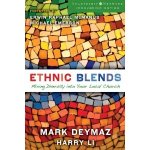 Mark DeYmaz and Harry Li, Ethnic Blends: Mixing Diversity into Your Local Church (Grand Rapids, MI: Zondervan, 2010). $18.99, 230 pages.
Mark DeYmaz and Harry Li, Ethnic Blends: Mixing Diversity into Your Local Church (Grand Rapids, MI: Zondervan, 2010). $18.99, 230 pages.
Demographers estimate that America will become a majority-minority nation by 2042. At the moment, whites account for a majority of Americans; by 2042, no one race or ethnic group will hold that distinction.[1] This demographic shift will change and complexify American ethnic relationships in ways that are difficult to predict.
Martin Luther King Jr. often lamented that 11:00 a.m. on Sunday morning was the most segregated hour of the American week. In their 2000 study, Divided by Faith, sociologists Christian Smith and Michael Emerson documented the depth of that segregation, especially among evangelical churches. The picture they painted was not pretty. For a variety of reasons, evangelical churches tended to be more segregated than other churches.
For Mark DeYmaz and Harry Li, ethnic segregation within evangelical churches is a repudiation of the gospel. In his 2007 book, Building a Healthy Multi-ethnic Church, DeYmaz outlined the theological framework for planting intentionally multi-ethnic churches. He focused on three New Testament passages: Jesus’ prayer for the church’s unity (John 17:20-23), the multi-ethnic mission of the Antioch church (Acts 11:19-26, 13:1), and the social implications of the gospel explicated by Paul in his letter to the Ephesians. Additionally, he outlined “seven core commitments” of a contemporary multi-ethnic church: embracing dependence, taking intentional steps, empowering diverse leaders, developing cross-cultural relationships, pursuing cross-cultural competence, promoting a spirit of inclusion, and mobilizing for impact.
Chapter 1 of Ethnic Blends summarizes DeYmaz’s earlier book. Chapters 2–8 outline seven practical obstacles pastors and parishioners will face when they set out to plant a multi-ethnic church or transform a homogeneous one. These obstacles are personal, theological, philosophical, practical, cross-cultural, relational, and spiritual in nature. DeYmaz and Li address these obstacles as practitioners rather than as theoreticians. They are lead pastor and campus pastor, respectively, of Mosaic Church in Little Rock, Arkansas — a city with an infamous history of segregation.
The book is practical. It is also irenic. DeYmaz and Li do not prophetically denounce homogeneous churches, even though they directly challenge the theology and practice of the homogenous unit principle, the key insight of the Church Growth Movement, which teaches that people like to come to Christ without crossing demographic boundaries. Instead, they patiently explain and defend the theological foundations of intentionally multi-ethnic churches, as well as realistically assess the difficulties of implementing this vision in contemporary America. Their book is heartfelt, and their stories are alternately heart-wrenching and hopeful.
Speaking for the nascent multi-ethnic church movement, DeYmaz and Li state a key goal of that movement: that 20% of American churches will be 20% ethnic minority by 2020 and that 50% of American churches will be 50% ethnic minority by 2050. Churches that strive to do so will demonstrate the unity of the church that Christ prayed for, the mission of the church that Antioch exemplified, and the social implications of the gospel that Paul taught in Ephesians.
Planting a multi-ethnic church, or transforming a homogeneous one, is not easy work. Majority bigotry is obviously a problem. But substantial differences of style and substance between ethnic minorities is also a major problem. Whether or not one ultimately agrees that multi-ethnic churches best exemplify the gospel, DeYmaz and Li make many insightful observations about how to relate to people who are different from you, whether they are Christian or not. In our increasingly multi-ethnic cultural context, I think these insights are timely and suggestive.
I highly recommend this book for anyone involved in planting and leading churches or training those who plant and lead (including denominational officials and seminary professors). As with any book, you will disagree with parts of Ethnic Blends. But I hope this book will also challenge thinking about church growth and help us align our church growth principles more closely with the gospel.
—–
P.S. If you found this review to be helpful, please vote “Yes” on my Amazon.com profile page.
[1] Of course, even the word white, as applied to people, covers a multitude of ethnicities, e.g., English, Scottish, Welsh, Irish, Italian, Spanish, Scandianavian, German, French, Slavic, etc. If we factor in white ethnic diversity, we may become a majority-minority nation sooner than 2042.

